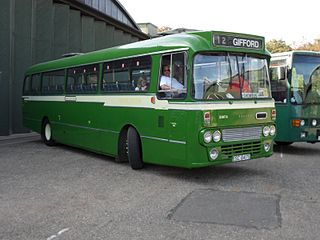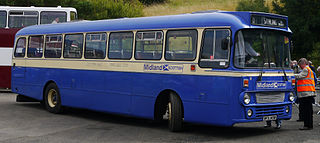
The AEC Routemaster is a front-engined double-decker bus that was designed by London Transport and built by the Associated Equipment Company (AEC) and Park Royal Vehicles. The first prototype was completed in September 1954 and the last one was delivered in 1968. The layout of the vehicle was conventional for the time, with a half-cab, front-mounted engine and open rear platform, although the coach version was fitted with rear platform doors. Forward entrance vehicles with platform doors were also produced as was a unique front-entrance prototype with the engine mounted transversely at the rear.

Strathclyde Partnership for Transport (SPT) is a regional transport partnership for the Strathclyde area of western Scotland. It is responsible for planning and coordinating regional transport, especially the public transport system in the area, including responsibility for operating the Glasgow Subway, the third-oldest in the world.

The North Clyde Line is a suburban railway in West Central Scotland. The route is operated by ScotRail. As a result of the incorporation of the Airdrie–Bathgate rail link and the Edinburgh–Bathgate line, this route has become the fourth rail link between Glasgow and Edinburgh.
Central Scottish Omnibuses Ltd was a bus operating subsidiary of the Scottish Transport Group formed in June 1985 from Central SMT, and operated until July 1989 when it was merged with Kelvin Scottish to form Kelvin Central Buses.

Clydeside Scottish Omnibuses Ltd was a bus operating subsidiary of the Scottish Transport Group formed in June 1985 from Western SMT Company Ltd. The company operated until May 1989, when it was remerged with Western Scottish, the successor company to Western SMT.

Eastern Scottish Omnibuses Ltd. was a bus and coach operator based in Edinburgh, Scotland and a subsidiary of the Scottish Bus Group. Eastern Scottish was formed in June 1985 from the main part of Scottish Omnibuses Ltd., which had itself traded as 'Eastern Scottish' since the 1960s. Following privatisation in 1990 the company traded as 'SMT' reviving the original name of the company. It operated until 1994, when it became part of GRT Bus Group plc.

Fife Scottish Omnibuses Ltd, is a bus operating company part of Stagecoach East Scotland based in Dunfermline, Scotland.

Midland Scottish Omnibuses Ltd was a bus operator formed in June 1985 as a subsidiary of the Scottish Bus Group, created from part of W. Alexander & Sons (Midland) Ltd. The company operated as Midland Scottish until 1991, when it was renamed Midland Bluebird in preparation for privatisation.

Stagecoach West Scotland is an operating region of Stagecoach UK Bus, comprising Western Buses Ltd based in Ayr, Scotland.

Magic Bus is a brand of Stagecoach Group for local bus operations in the United Kingdom, usually operated on routes with strong competition from other operators. The brand is currently used in Manchester and in the past has been used in Glasgow, Newcastle, Liverpool, and Rotherham. A similar brand Magic Mini have also been used in Corby, Ayrshire and the Scottish Highlands.

Kelvin Central Buses was a bus operator in Scotland. Formed as a subsidiary of the Scottish Bus Group in July 1989 from the merger of Kelvin Scottish and Central Scottish, it was sold in a management buyout and in July 1998 became part of First Glasgow.
First Stop Travel was a Scottish bus company, which operated primarily in Renfrewshire and southwest Glasgow. Its depot was located in Muriel Street, Barrhead. It was closed in 2008 after the Traffic Commissioner revoked its licence.

Arriva Scotland West was a bus company based in Inchinnan, near Paisley, Scotland. It was formed in 1997 as a rebranding of the former Clydeside 2000 company when purchased by Arriva. On 26 March 2012, the business was sold to McGill's Bus Services.

First Glasgow is the largest bus company serving the Greater Glasgow area in Scotland. It is a subsidiary of FirstGroup. The company operates within the area covered by the Strathclyde Partnership for Transport, a public body responsible for helping to co-ordinate public transport services in the Greater Glasgow area.

Buchanan Bus Station is the main bus terminus in Glasgow, Scotland, and is located between the Townhead and Cowcaddens districts on the north eastern side of the city centre. It is the terminus for journeys between the city and other towns and cities in Scotland, as well as long-distance services to other parts of the United Kingdom and some international journeys.

McKindless was a Scottish bus operator, operating a number of bus routes throughout Greater Glasgow, Scotland. The company was based in Newmains and had a depot in Parkhead.

Dart Buses was an independent bus operator in the Paisley and Renfrewshire area in the 1990s. The company is attributed with starting a bus war with the main operator of the area, Clydeside Scottish. Bus wars were common following bus deregulation, and the Paisley area was no stranger to fierce competition; however Dart Buses predominantly operated along routes of large operators and were more successful and subsequently grew much larger than other independents. The company collapsed in 2001.

Strathclyde Buses was a bus operating company in Glasgow and west-central Scotland. It commenced operations in October 1986. Prior to 1986, the council-owned buses had belonged to Strathclyde Passenger Transport Executive, and therefore were owned by Strathclyde Regional Council. The new company, although still under the control of the Council, was no longer able to rely on the Council for any financial, or any other, help. In 1996 the company was taken over by FirstGroup. Its former operations are now part of First Glasgow.

The Seddon Pennine 7 was a mid-underfloor-engined single-deck bus or coach chassis built by Seddon Atkinson between 1974 and 1982.

British Coachways was a consortium of independent coach operating companies in the United Kingdom. Formed immediately after the deregulation of coach services in October 1980, it competed with the state-owned National Express and Scottish Bus Group on a range of long-distance routes. Initially composed of six members, it varied in size and composition over its two years of operation to include a range of ten different companies.






















